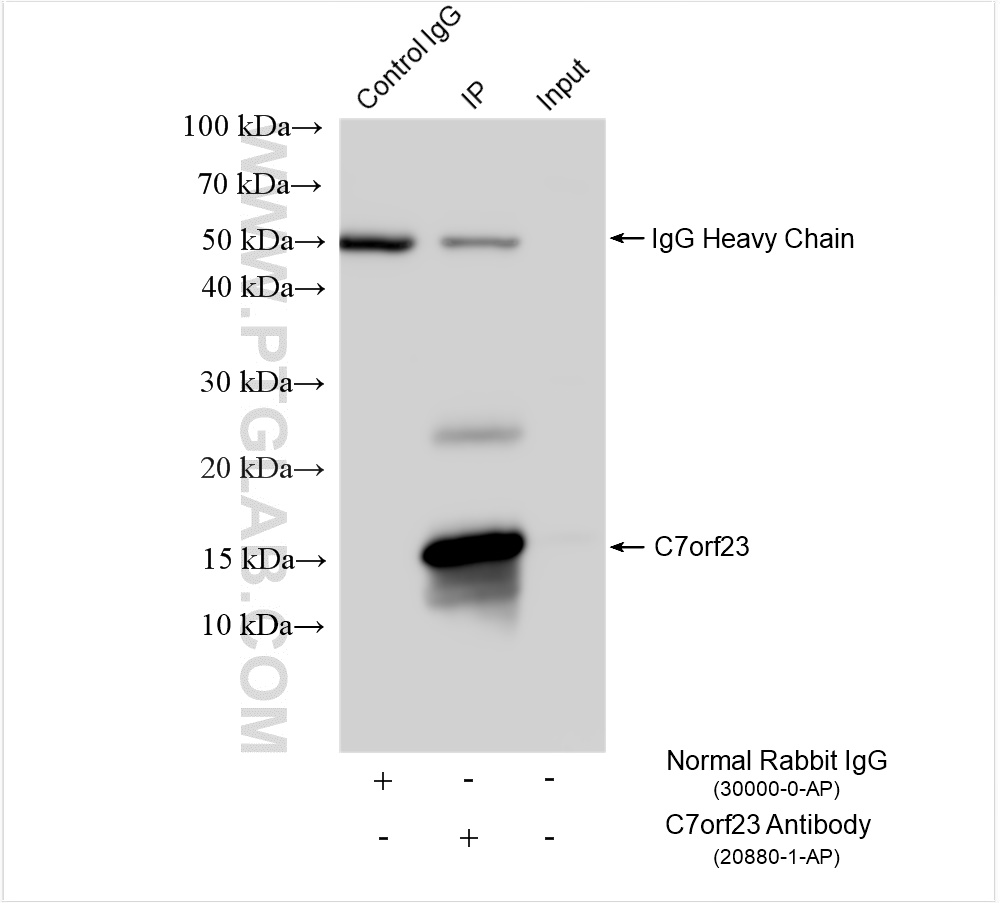C7orf23 Polyclonal antibody
C7orf23 Polyclonal Antibody for IP, ELISA
Host / Isotype
Rabbit / IgG
Reactivity
human
Applications
IP, ELISA
Conjugate
Unconjugated
Cat no : 20880-1-AP
Synonyms
Validation Data Gallery
Tested Applications
| Positive IP detected in | Ramos cells |
Recommended dilution
| Application | Dilution |
|---|---|
| Immunoprecipitation (IP) | IP : 0.5-4.0 ug for 1.0-3.0 mg of total protein lysate |
| It is recommended that this reagent should be titrated in each testing system to obtain optimal results. | |
| Sample-dependent, Check data in validation data gallery. | |
Product Information
20880-1-AP targets C7orf23 in IP, ELISA applications and shows reactivity with human samples.
| Tested Reactivity | human |
| Host / Isotype | Rabbit / IgG |
| Class | Polyclonal |
| Type | Antibody |
| Immunogen | C7orf23 fusion protein Ag14979 |
| Full Name | chromosome 7 open reading frame 23 |
| Calculated Molecular Weight | 118 aa, 13 kDa |
| Observed Molecular Weight | 16 kDa |
| GenBank Accession Number | BC002837 |
| Gene Symbol | C7orf23 |
| Gene ID (NCBI) | 79161 |
| Conjugate | Unconjugated |
| Form | Liquid |
| Purification Method | Antigen affinity purification |
| Storage Buffer | PBS with 0.02% sodium azide and 50% glycerol pH 7.3. |
| Storage Conditions | Store at -20°C. Stable for one year after shipment. Aliquoting is unnecessary for -20oC storage. 20ul sizes contain 0.1% BSA. |
Background Information
C7orf23, also known as TMEM243, encodes a membrane protein that may be associated with drug tolerance in cells. The C7orf23 gene is capable of generating at least 12 different splice variants, 10 of which are capable of encoding 7 different protein isoforms, some of which contain transmembrane structural domains. Recent studies have shown that C7orf23 is significantly up-regulated and highly sensitive in blood samples from PD patients, revealing its potential as a future biomarker for PD diagnosis.
Protocols
| Product Specific Protocols | |
|---|---|
| IP protocol for C7orf23 antibody 20880-1-AP | Download protocol |
| Standard Protocols | |
|---|---|
| Click here to view our Standard Protocols |


